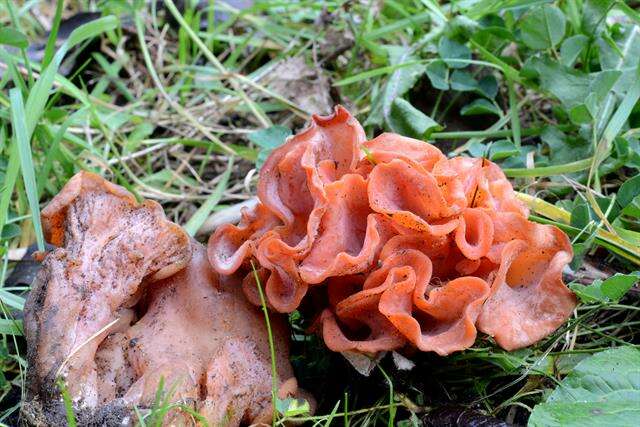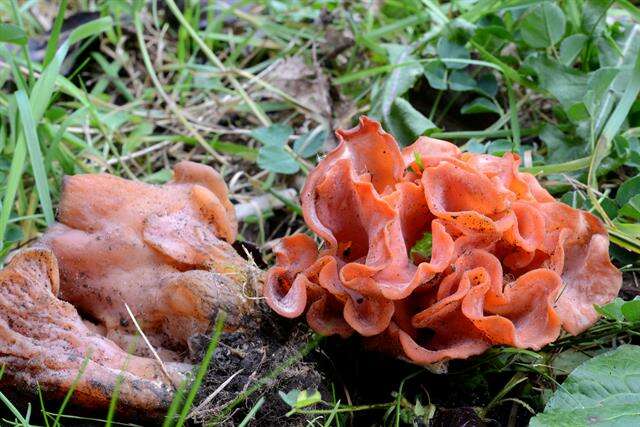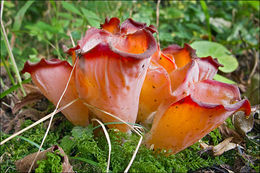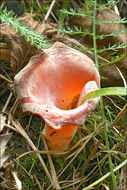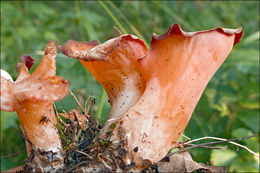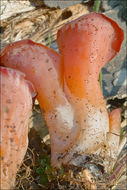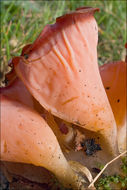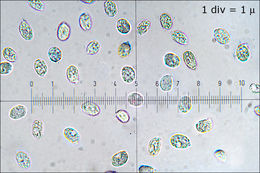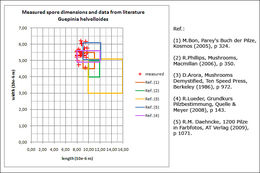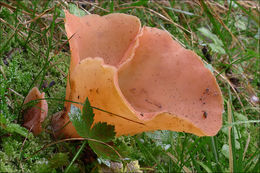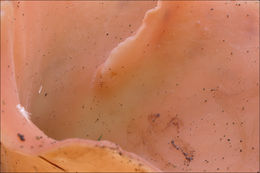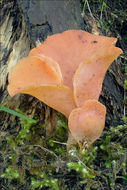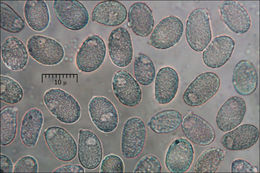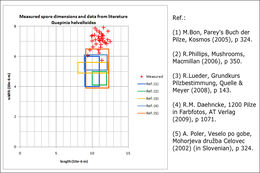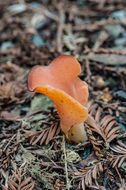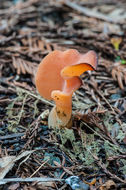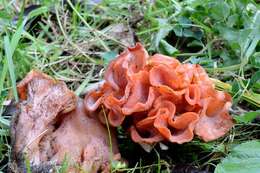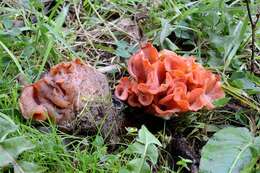-
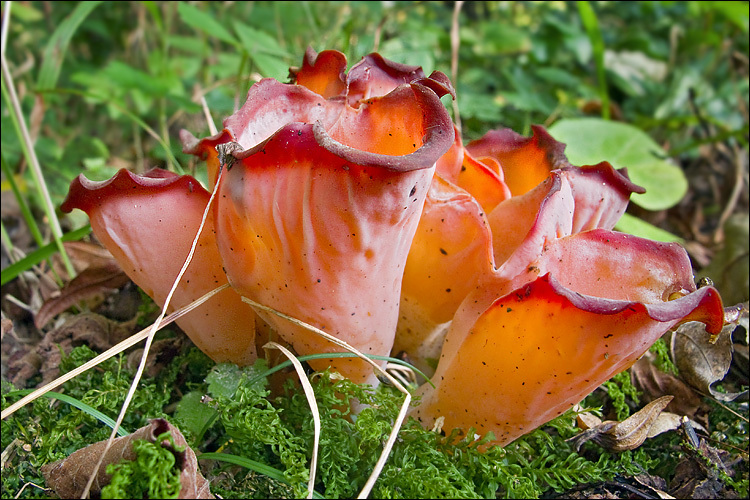
Slo.: uhati drhtave - Habitat: trail side, among herbs, under trees and bushes, in shade, humid place close to a stream, flat terrain, calcareous ground, partly protected from direct rain by shrub and tree canopies, average precipitations ~ 3.000 mm/year, average temperature 8-10 deg C, elevation 370 m (1.200 feet), alpine phytogeographical region. - Substratum: soil full of leaf and wood debris. - Comments: Growing in several groups with many sporocarps and solitary, pileus diameter up to 5 cm (2 inch) and up to 7 cm (3 inch) tall, taste and smell mild and pleasant, flesh soft rubbery, SP whitish. Spore dimensions do not fit well to data from literature? However, scatter of this character among different authors is very large. Spores smooth. Dimensions: 8.8 (SD = 0.6) x 5.5 (SD = 0.4) micr., Q = 1.61 (SD = 0.15), n = 30. Motic B2-211A, magnification 1.000 x, oil, in water. - Ref.: (1) M.Bon, Parey's Buch der Pilze, Kosmos (2005), p 324. (2) R.Phillips, Mushrooms, Macmillan (2006), p 350. (3) D.Arora, Mushrooms Demystified, Ten Speed Press, Berkeley (1986), p 972. (4) R.Lueder, Grundkurs Pilzbestimmung, Quelle & Meyer (2008), p 143. (5) R.M. Daehncke, 1200 Pilze in Farbfotos, AT Verlag (2009), p 1071.
-

Slo.: uhati drhtave - Habitat: trail side, among herbs, under trees and bushes, in shade, humid place close to a stream, flat terrain, calcareous ground, partly protected from direct rain by shrub and tree canopies, average precipitations ~ 3.000 mm/year, average temperature 8-10 deg C, elevation 370 m (1.200 feet), alpine phytogeographical region. - Substratum: soil full of leaf and wood debris. - Comments: Growing in several groups with many sporocarps and solitary, pileus diameter up to 5 cm (2 inch) and up to 7 cm (3 inch) tall, taste and smell mild and pleasant, flesh soft rubbery, SP whitish. Spore dimensions do not fit well to data from literature? However, scatter of this character among different authors is very large. Spores smooth. Dimensions: 8.8 (SD = 0.6) x 5.5 (SD = 0.4) micr., Q = 1.61 (SD = 0.15), n = 30. Motic B2-211A, magnification 1.000 x, oil, in water. - Ref.: (1) M.Bon, Parey's Buch der Pilze, Kosmos (2005), p 324. (2) R.Phillips, Mushrooms, Macmillan (2006), p 350. (3) D.Arora, Mushrooms Demystified, Ten Speed Press, Berkeley (1986), p 972. (4) R.Lueder, Grundkurs Pilzbestimmung, Quelle & Meyer (2008), p 143. (5) R.M. Daehncke, 1200 Pilze in Farbfotos, AT Verlag (2009), p 1071.
-
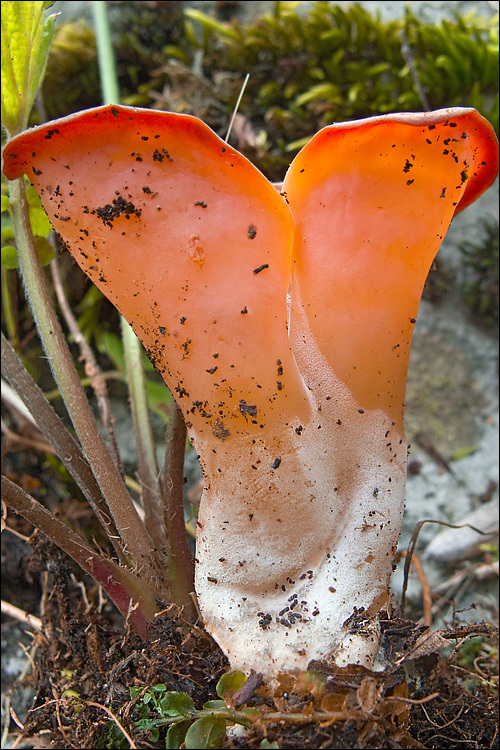
Slo.: uhati drhtave - Habitat: trail side, among herbs, under trees and bushes, in shade, humid place close to a stream, flat terrain, calcareous ground, partly protected from direct rain by shrub and tree canopies, average precipitations ~ 3.000 mm/year, average temperature 8-10 deg C, elevation 370 m (1.200 feet), alpine phytogeographical region. - Substratum: soil full of leaf and wood debris. - Comments: Growing in several groups with many sporocarps and solitary, pileus diameter up to 5 cm (2 inch) and up to 7 cm (3 inch) tall, taste and smell mild and pleasant, flesh soft rubbery, SP whitish. Spore dimensions do not fit well to data from literature? However, scatter of this character among different authors is very large. Spores smooth. Dimensions: 8.8 (SD = 0.6) x 5.5 (SD = 0.4) micr., Q = 1.61 (SD = 0.15), n = 30. Motic B2-211A, magnification 1.000 x, oil, in water. - Ref.: (1) M.Bon, Parey's Buch der Pilze, Kosmos (2005), p 324. (2) R.Phillips, Mushrooms, Macmillan (2006), p 350. (3) D.Arora, Mushrooms Demystified, Ten Speed Press, Berkeley (1986), p 972. (4) R.Lueder, Grundkurs Pilzbestimmung, Quelle & Meyer (2008), p 143. (5) R.M. Daehncke, 1200 Pilze in Farbfotos, AT Verlag (2009), p 1071.
-

Slo.: uhati drhtave - Habitat: trail side, among herbs, under trees and bushes, in shade, humid place close to a stream, flat terrain, calcareous ground, partly protected from direct rain by shrub and tree canopies, average precipitations ~ 3.000 mm/year, average temperature 8-10 deg C, elevation 370 m (1.200 feet), alpine phytogeographical region. - Substratum: soil full of leaf and wood debris. - Comments: Growing in several groups with many sporocarps and solitary, pileus diameter up to 5 cm (2 inch) and up to 7 cm (3 inch) tall, taste and smell mild and pleasant, flesh soft rubbery, SP whitish. Spore dimensions do not fit well to data from literature? However, scatter of this character among different authors is very large. Spores smooth. Dimensions: 8.8 (SD = 0.6) x 5.5 (SD = 0.4) micr., Q = 1.61 (SD = 0.15), n = 30. Motic B2-211A, magnification 1.000 x, oil, in water. - Ref.: (1) M.Bon, Parey's Buch der Pilze, Kosmos (2005), p 324. (2) R.Phillips, Mushrooms, Macmillan (2006), p 350. (3) D.Arora, Mushrooms Demystified, Ten Speed Press, Berkeley (1986), p 972. (4) R.Lueder, Grundkurs Pilzbestimmung, Quelle & Meyer (2008), p 143. (5) R.M. Daehncke, 1200 Pilze in Farbfotos, AT Verlag (2009), p 1071.
-

Slo.: uhati drhtave - Habitat: trail side, among herbs, under trees and bushes, in shade, humid place close to a stream, flat terrain, calcareous ground, partly protected from direct rain by shrub and tree canopies, average precipitations ~ 3.000 mm/year, average temperature 8-10 deg C, elevation 370 m (1.200 feet), alpine phytogeographical region. - Substratum: soil full of leaf and wood debris. - Comments: Growing in several groups with many sporocarps and solitary, pileus diameter up to 5 cm (2 inch) and up to 7 cm (3 inch) tall, taste and smell mild and pleasant, flesh soft rubbery, SP whitish. Spore dimensions do not fit well to data from literature? However, scatter of this character among different authors is very large. Spores smooth. Dimensions: 8.8 (SD = 0.6) x 5.5 (SD = 0.4) micr., Q = 1.61 (SD = 0.15), n = 30. Motic B2-211A, magnification 1.000 x, oil, in water. - Ref.: (1) M.Bon, Parey's Buch der Pilze, Kosmos (2005), p 324. (2) R.Phillips, Mushrooms, Macmillan (2006), p 350. (3) D.Arora, Mushrooms Demystified, Ten Speed Press, Berkeley (1986), p 972. (4) R.Lueder, Grundkurs Pilzbestimmung, Quelle & Meyer (2008), p 143. (5) R.M. Daehncke, 1200 Pilze in Farbfotos, AT Verlag (2009), p 1071.
-
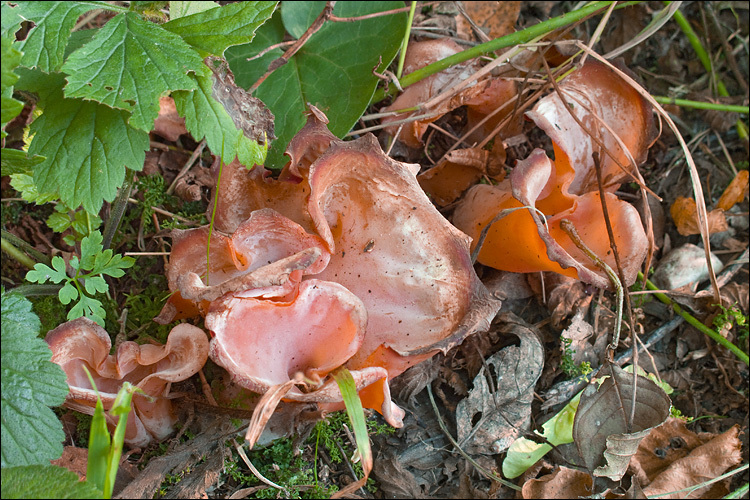
Slo.: uhati drhtave - Habitat: trail side, among herbs, under trees and bushes, in shade, humid place close to a stream, flat terrain, calcareous ground, partly protected from direct rain by shrub and tree canopies, average precipitations ~ 3.000 mm/year, average temperature 8-10 deg C, elevation 370 m (1.200 feet), alpine phytogeographical region. - Substratum: soil full of leaf and wood debris. - Comments: Growing in several groups with many sporocarps and solitary, pileus diameter up to 5 cm (2 inch) and up to 7 cm (3 inch) tall, taste and smell mild and pleasant, flesh soft rubbery, SP whitish. Spore dimensions do not fit well to data from literature? However, scatter of this character among different authors is very large. Spores smooth. Dimensions: 8.8 (SD = 0.6) x 5.5 (SD = 0.4) micr., Q = 1.61 (SD = 0.15), n = 30. Motic B2-211A, magnification 1.000 x, oil, in water. - Ref.: (1) M.Bon, Parey's Buch der Pilze, Kosmos (2005), p 324. (2) R.Phillips, Mushrooms, Macmillan (2006), p 350. (3) D.Arora, Mushrooms Demystified, Ten Speed Press, Berkeley (1986), p 972. (4) R.Lueder, Grundkurs Pilzbestimmung, Quelle & Meyer (2008), p 143. (5) R.M. Daehncke, 1200 Pilze in Farbfotos, AT Verlag (2009), p 1071.
-

Slo.: uhati drhtave - Habitat: trail side, among herbs, under trees and bushes, in shade, humid place close to a stream, flat terrain, calcareous ground, partly protected from direct rain by shrub and tree canopies, average precipitations ~ 3.000 mm/year, average temperature 8-10 deg C, elevation 370 m (1.200 feet), alpine phytogeographical region. - Substratum: soil full of leaf and wood debris. - Comments: Growing in several groups with many sporocarps and solitary, pileus diameter up to 5 cm (2 inch) and up to 7 cm (3 inch) tall, taste and smell mild and pleasant, flesh soft rubbery, SP whitish. Spore dimensions do not fit well to data from literature? However, scatter of this character among different authors is very large. Spores smooth. Dimensions: 8.8 (SD = 0.6) x 5.5 (SD = 0.4) micr., Q = 1.61 (SD = 0.15), n = 30. Motic B2-211A, magnification 1.000 x, oil, in water. - Ref.: (1) M.Bon, Parey's Buch der Pilze, Kosmos (2005), p 324. (2) R.Phillips, Mushrooms, Macmillan (2006), p 350. (3) D.Arora, Mushrooms Demystified, Ten Speed Press, Berkeley (1986), p 972. (4) R.Lueder, Grundkurs Pilzbestimmung, Quelle & Meyer (2008), p 143. (5) R.M. Daehncke, 1200 Pilze in Farbfotos, AT Verlag (2009), p 1071.
-
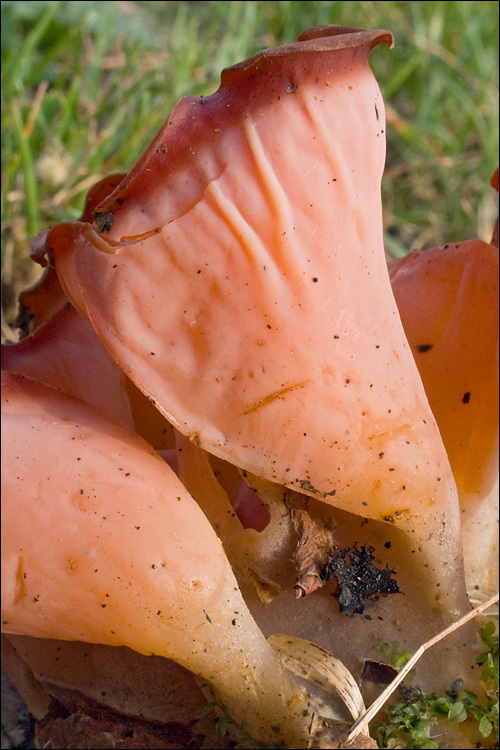
Slo.: uhati drhtave - Habitat: trail side, among herbs, under trees and bushes, in shade, humid place close to a stream, flat terrain, calcareous ground, partly protected from direct rain by shrub and tree canopies, average precipitations ~ 3.000 mm/year, average temperature 8-10 deg C, elevation 370 m (1.200 feet), alpine phytogeographical region. - Substratum: soil full of leaf and wood debris. - Comments: Growing in several groups with many sporocarps and solitary, pileus diameter up to 5 cm (2 inch) and up to 7 cm (3 inch) tall, taste and smell mild and pleasant, flesh soft rubbery, SP whitish. Spore dimensions do not fit well to data from literature? However, scatter of this character among different authors is very large. Spores smooth. Dimensions: 8.8 (SD = 0.6) x 5.5 (SD = 0.4) micr., Q = 1.61 (SD = 0.15), n = 30. Motic B2-211A, magnification 1.000 x, oil, in water. - Ref.: (1) M.Bon, Parey's Buch der Pilze, Kosmos (2005), p 324. (2) R.Phillips, Mushrooms, Macmillan (2006), p 350. (3) D.Arora, Mushrooms Demystified, Ten Speed Press, Berkeley (1986), p 972. (4) R.Lueder, Grundkurs Pilzbestimmung, Quelle & Meyer (2008), p 143. (5) R.M. Daehncke, 1200 Pilze in Farbfotos, AT Verlag (2009), p 1071.
-
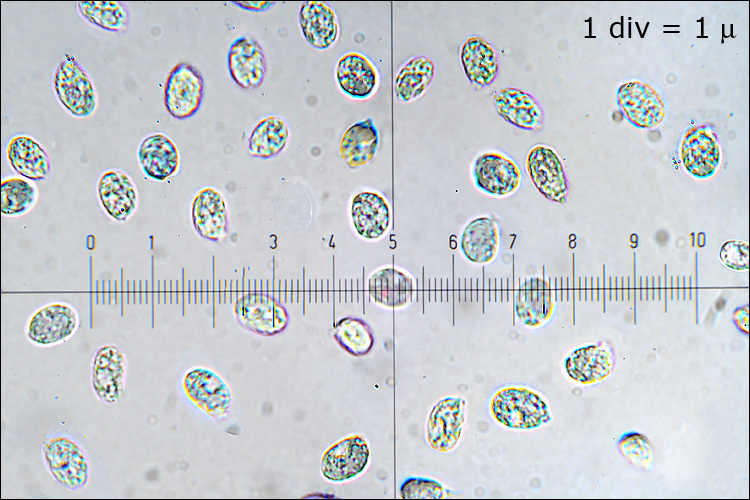
Slo.: uhati drhtave - Habitat: trail side, among herbs, under trees and bushes, in shade, humid place close to a stream, flat terrain, calcareous ground, partly protected from direct rain by shrub and tree canopies, average precipitations ~ 3.000 mm/year, average temperature 8-10 deg C, elevation 370 m (1.200 feet), alpine phytogeographical region. - Substratum: soil full of leaf and wood debris. - Comments: Growing in several groups with many sporocarps and solitary, pileus diameter up to 5 cm (2 inch) and up to 7 cm (3 inch) tall, taste and smell mild and pleasant, flesh soft rubbery, SP whitish. Spore dimensions do not fit well to data from literature? However, scatter of this character among different authors is very large. Spores smooth. Dimensions: 8.8 (SD = 0.6) x 5.5 (SD = 0.4) micr., Q = 1.61 (SD = 0.15), n = 30. Motic B2-211A, magnification 1.000 x, oil, in water. - Ref.: (1) M.Bon, Parey's Buch der Pilze, Kosmos (2005), p 324. (2) R.Phillips, Mushrooms, Macmillan (2006), p 350. (3) D.Arora, Mushrooms Demystified, Ten Speed Press, Berkeley (1986), p 972. (4) R.Lueder, Grundkurs Pilzbestimmung, Quelle & Meyer (2008), p 143. (5) R.M. Daehncke, 1200 Pilze in Farbfotos, AT Verlag (2009), p 1071.
-
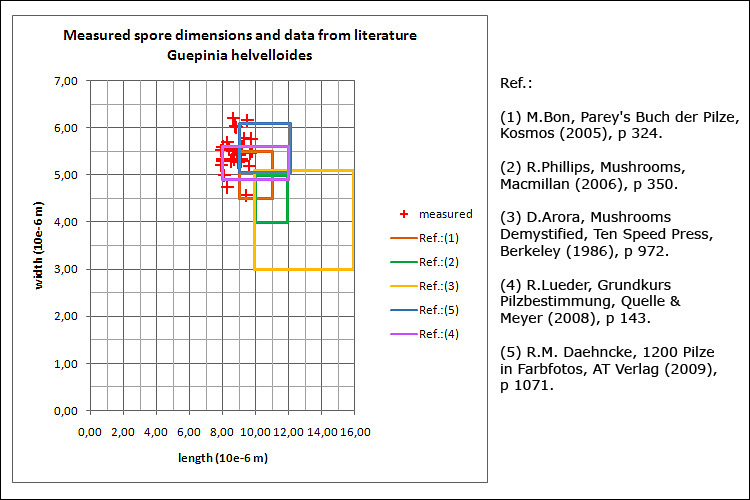
Slo.: uhati drhtave - Habitat: trail side, among herbs, under trees and bushes, in shade, humid place close to a stream, flat terrain, calcareous ground, partly protected from direct rain by shrub and tree canopies, average precipitations ~ 3.000 mm/year, average temperature 8-10 deg C, elevation 370 m (1.200 feet), alpine phytogeographical region. - Substratum: soil full of leaf and wood debris. - Comments: Growing in several groups with many sporocarps and solitary, pileus diameter up to 5 cm (2 inch) and up to 7 cm (3 inch) tall, taste and smell mild and pleasant, flesh soft rubbery, SP whitish. Spore dimensions do not fit well to data from literature? However, scatter of this character among different authors is very large. Spores smooth. Dimensions: 8.8 (SD = 0.6) x 5.5 (SD = 0.4) micr., Q = 1.61 (SD = 0.15), n = 30. Motic B2-211A, magnification 1.000 x, oil, in water. - Ref.: (1) M.Bon, Parey's Buch der Pilze, Kosmos (2005), p 324. (2) R.Phillips, Mushrooms, Macmillan (2006), p 350. (3) D.Arora, Mushrooms Demystified, Ten Speed Press, Berkeley (1986), p 972. (4) R.Lueder, Grundkurs Pilzbestimmung, Quelle & Meyer (2008), p 143. (5) R.M. Daehncke, 1200 Pilze in Farbfotos, AT Verlag (2009), p 1071.
-
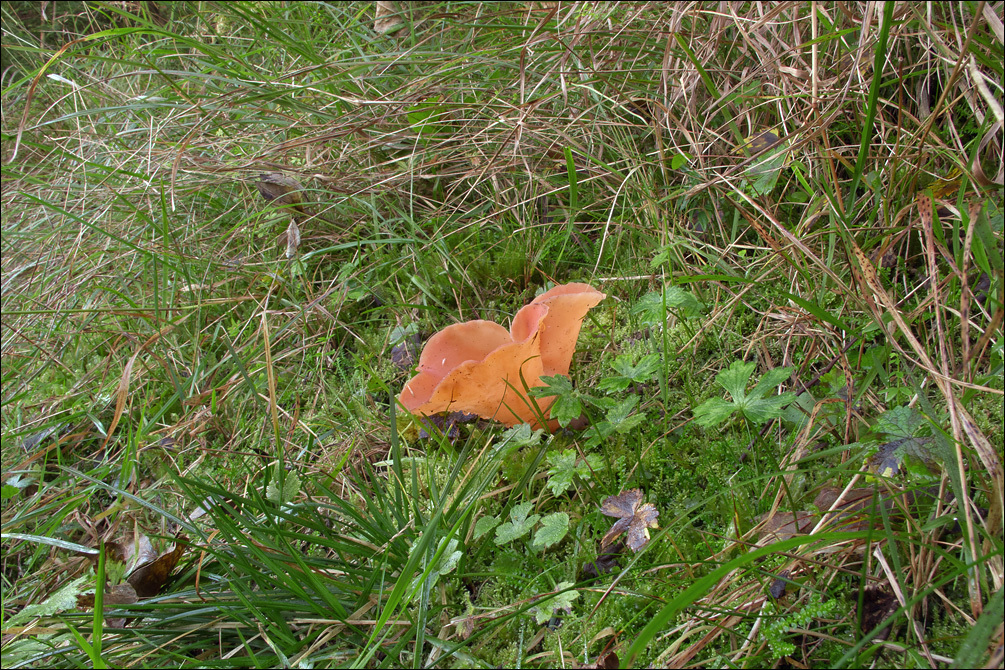
Slo.: uhati drhtave, donk, uhelj - syn.: Guepinia rufa (Jacq.) Beck, Phlogiotis helvelloides (DC.) G.W. Martin, Tremella helvelloides DC., Tremiscus helvelloides (DC.) Donk - Habitat: River bank, wood edge, Picea abies dominant, next to a trail, almost flat terrain, quite-open place, partly sunny, air and ground humid place; calcareous, alluvial, sandy ground; exposed to direct rain, average precipitations ~ 3.000 mm/year, average temperature 7-9 deg C, elevation 565 m (1.850 feet), alpine phytogeographical region.Substratum: soil, possibly buried wood in the last phase of disintegration.Comments: Guepinia helvelloides is not a rare find in Trenta valley. However, this time the find was extremely large, exceeding in size all data in literature I am aware off. Usually the sporocarps are about 5-6 cm tall. Interestingly, also spore width does not fit into expected limits. Spores are significantly larger, so one could suspect a wrong determination of the find. However, to my knowledge, there is nothing similar to this mushroom growing in Slovenia.Growing solitary, two pilei fuzzed at the base; dimensions of the larger 11.5 x 10 cm across and 10.5 cm tall; stipe rudimentary, about 2 cm long and 1.5 cm in diameter, partly hollow; taste mild pleasant, mushroomy; smell indistinctive, on moss(?), SP white, oac909.Spores minutely warty. Dimensions: 9.6 [10.8 ; 11.2] 12.4 x 6.1 [7 ; 7.3] 8.2 microns; Q = 1.3 [1.5 ; 1.6] 1.8; N = 38; C = 95%; Me = 11 x 7.1 microns ; Qe = 1.6. Olympus CH20, NEA 100x/1.25, magnification 1.000 x, oil, fresh material; in water. AmScope MA500 digital camera.Herbarium: Mycotheca and lichen herbarium (LJU-Li) of Slovenian Forestry Institute, Vena pot 2, Ljubljana, Index Herbariorum LJFRef.:(1) M.Bon, Parey's Buch der Pilze, Kosmos (2005), p 324. (2) R.Phillips, Mushrooms, Macmillan (2006), p 350. (3) R.Lueder, Grundkurs Pilzbestimmung, Quelle & Meyer (2008), p 143. (4) R.M. Daehncke, 1200 Pilze in Farbfotos, AT Verlag (2009), p 1071. (5) A. Poler, Veselo po gobe, Mohorjeva druba Celovec (2002) (in Slovenian), p 324. SP 9-12/4-6.5(6) G.J. Krieglsteiner (Hrsg.), Die Grosspilze Baden-Wrttembergs, Band 1., Ulmer (2000), p 128.
-

Slo.: uhati drhtave, donk, uhelj - syn.: Guepinia rufa (Jacq.) Beck, Phlogiotis helvelloides (DC.) G.W. Martin, Tremella helvelloides DC., Tremiscus helvelloides (DC.) Donk - Habitat: River bank, wood edge, Picea abies dominant, next to a trail, almost flat terrain, quite-open place, partly sunny, air and ground humid place; calcareous, alluvial, sandy ground; exposed to direct rain, average precipitations ~ 3.000 mm/year, average temperature 7-9 deg C, elevation 565 m (1.850 feet), alpine phytogeographical region. Substratum: soil, possibly buried wood in the last phase of disintegration. Comments: Guepinia helvelloides is not a rare find in Trenta valley. However, this time the find was extremely large, exceeding in size all data in literature I am aware off. Usually the sporocarps are about 5-6 cm tall. Interestingly, also spore width does not fit into expected limits. Spores are significantly larger, so one could suspect a wrong determination of the find. However, to my knowledge, there is nothing similar to this mushroom growing in Slovenia. Growing solitary, two pilei fuzzed at the base; dimensions of the larger 11.5 x 10 cm across and 10.5 cm tall; stipe rudimentary, about 2 cm long and 1.5 cm in diameter, partly hollow; taste mild pleasant, mushroomy; smell indistinctive, on moss(?), SP white, oac909. Spores minutely warty. Dimensions: 9.6 [10.8 ; 11.2] 12.4 x 6.1 [7 ; 7.3] 8.2 microns; Q = 1.3 [1.5 ; 1.6] 1.8; N = 38; C = 95%; Me = 11 x 7.1 microns ; Qe = 1.6. Olympus CH20, NEA 100x/1.25, magnification 1.000 x, oil, fresh material; in water. AmScope MA500 digital camera. Herbarium: Mycotheca and lichen herbarium (LJU-Li) of Slovenian Forestry Institute, Vena pot 2, Ljubljana, Index Herbariorum LJF Ref.: (1) M.Bon, Parey's Buch der Pilze, Kosmos (2005), p 324. (2) R.Phillips, Mushrooms, Macmillan (2006), p 350. (3) R.Lueder, Grundkurs Pilzbestimmung, Quelle & Meyer (2008), p 143. (4) R.M. Daehncke, 1200 Pilze in Farbfotos, AT Verlag (2009), p 1071. (5) A. Poler, Veselo po gobe, Mohorjeva druba Celovec (2002) (in Slovenian), p 324. SP 9-12/4-6.5(6) G.J. Krieglsteiner (Hrsg.), Die Grosspilze Baden-Wrttembergs, Band 1., Ulmer (2000), p 128.
-
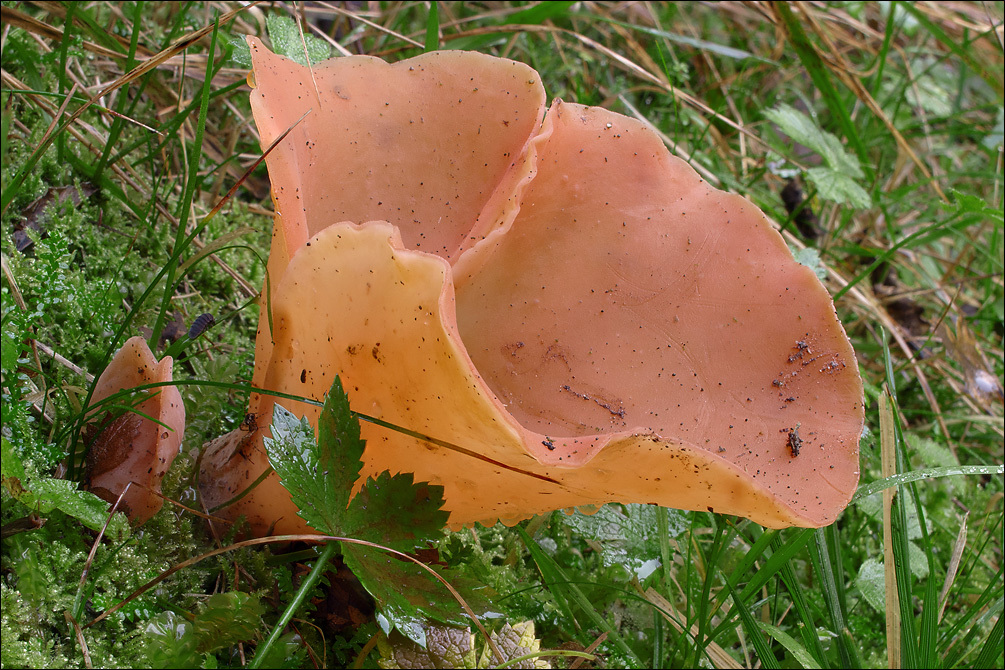
Slo.: uhati drhtave, donk, uhelj - syn.: Guepinia rufa (Jacq.) Beck, Phlogiotis helvelloides (DC.) G.W. Martin, Tremella helvelloides DC., Tremiscus helvelloides (DC.) Donk - Habitat: River bank, wood edge, Picea abies dominant, next to a trail, almost flat terrain, quite-open place, partly sunny, air and ground humid place; calcareous, alluvial, sandy ground; exposed to direct rain, average precipitations ~ 3.000 mm/year, average temperature 7-9 deg C, elevation 565 m (1.850 feet), alpine phytogeographical region. Substratum: soil, possibly buried wood in the last phase of disintegration. Comments: Guepinia helvelloides is not a rare find in Trenta valley. However, this time the find was extremely large, exceeding in size all data in literature I am aware off. Usually the sporocarps are about 5-6 cm tall. Interestingly, also spore width does not fit into expected limits. Spores are significantly larger, so one could suspect a wrong determination of the find. However, to my knowledge, there is nothing similar to this mushroom growing in Slovenia. Growing solitary, two pilei fuzzed at the base; dimensions of the larger 11.5 x 10 cm across and 10.5 cm tall; stipe rudimentary, about 2 cm long and 1.5 cm in diameter, partly hollow; taste mild pleasant, mushroomy; smell indistinctive, on moss(?), SP white, oac909. Spores minutely warty. Dimensions: 9.6 [10.8 ; 11.2] 12.4 x 6.1 [7 ; 7.3] 8.2 microns; Q = 1.3 [1.5 ; 1.6] 1.8; N = 38; C = 95%; Me = 11 x 7.1 microns ; Qe = 1.6. Olympus CH20, NEA 100x/1.25, magnification 1.000 x, oil, fresh material; in water. AmScope MA500 digital camera. Herbarium: Mycotheca and lichen herbarium (LJU-Li) of Slovenian Forestry Institute, Vena pot 2, Ljubljana, Index Herbariorum LJF Ref.: (1) M.Bon, Parey's Buch der Pilze, Kosmos (2005), p 324. (2) R.Phillips, Mushrooms, Macmillan (2006), p 350. (3) R.Lueder, Grundkurs Pilzbestimmung, Quelle & Meyer (2008), p 143. (4) R.M. Daehncke, 1200 Pilze in Farbfotos, AT Verlag (2009), p 1071. (5) A. Poler, Veselo po gobe, Mohorjeva druba Celovec (2002) (in Slovenian), p 324. SP 9-12/4-6.5(6) G.J. Krieglsteiner (Hrsg.), Die Grosspilze Baden-Wrttembergs, Band 1., Ulmer (2000), p 128.
-

Slo.: uhati drhtave, donk, uhelj - syn.: Guepinia rufa (Jacq.) Beck, Phlogiotis helvelloides (DC.) G.W. Martin, Tremella helvelloides DC., Tremiscus helvelloides (DC.) Donk - Habitat: River bank, wood edge, Picea abies dominant, next to a trail, almost flat terrain, quite-open place, partly sunny, air and ground humid place; calcareous, alluvial, sandy ground; exposed to direct rain, average precipitations ~ 3.000 mm/year, average temperature 7-9 deg C, elevation 565 m (1.850 feet), alpine phytogeographical region. Substratum: soil, possibly buried wood in the last phase of disintegration. Comments: Guepinia helvelloides is not a rare find in Trenta valley. However, this time the find was extremely large, exceeding in size all data in literature I am aware off. Usually the sporocarps are about 5-6 cm tall. Interestingly, also spore width does not fit into expected limits. Spores are significantly larger, so one could suspect a wrong determination of the find. However, to my knowledge, there is nothing similar to this mushroom growing in Slovenia. Growing solitary, two pilei fuzzed at the base; dimensions of the larger 11.5 x 10 cm across and 10.5 cm tall; stipe rudimentary, about 2 cm long and 1.5 cm in diameter, partly hollow; taste mild pleasant, mushroomy; smell indistinctive, on moss(?), SP white, oac909. Spores minutely warty. Dimensions: 9.6 [10.8 ; 11.2] 12.4 x 6.1 [7 ; 7.3] 8.2 microns; Q = 1.3 [1.5 ; 1.6] 1.8; N = 38; C = 95%; Me = 11 x 7.1 microns ; Qe = 1.6. Olympus CH20, NEA 100x/1.25, magnification 1.000 x, oil, fresh material; in water. AmScope MA500 digital camera. Herbarium: Mycotheca and lichen herbarium (LJU-Li) of Slovenian Forestry Institute, Vena pot 2, Ljubljana, Index Herbariorum LJF Ref.: (1) M.Bon, Parey's Buch der Pilze, Kosmos (2005), p 324. (2) R.Phillips, Mushrooms, Macmillan (2006), p 350. (3) R.Lueder, Grundkurs Pilzbestimmung, Quelle & Meyer (2008), p 143. (4) R.M. Daehncke, 1200 Pilze in Farbfotos, AT Verlag (2009), p 1071. (5) A. Poler, Veselo po gobe, Mohorjeva druba Celovec (2002) (in Slovenian), p 324. SP 9-12/4-6.5(6) G.J. Krieglsteiner (Hrsg.), Die Grosspilze Baden-Wrttembergs, Band 1., Ulmer (2000), p 128.
-
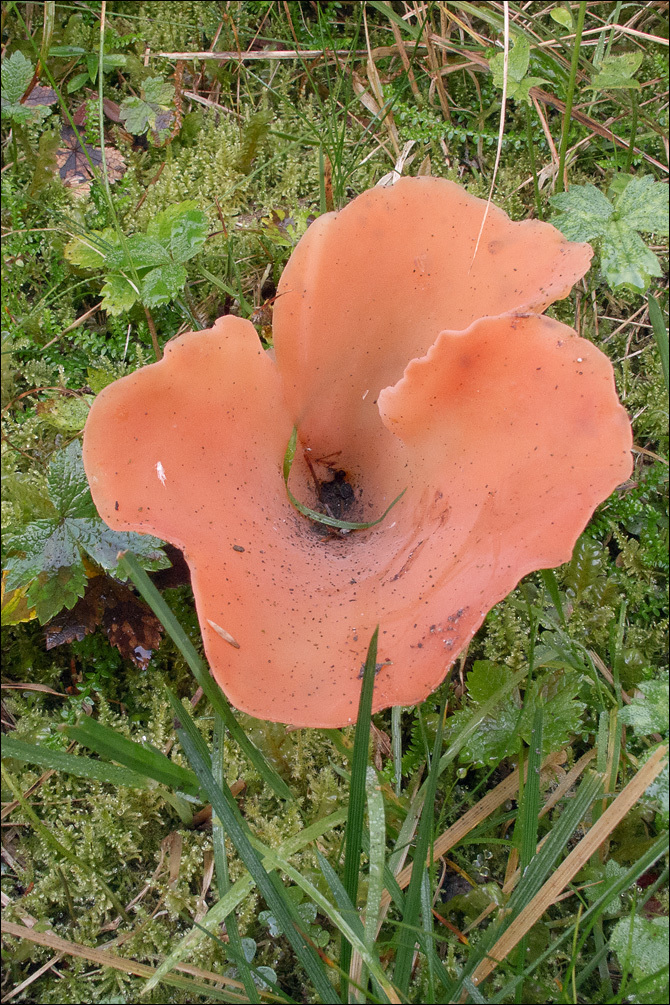
Slo.: uhati drhtave, donk, uhelj - syn.: Guepinia rufa (Jacq.) Beck, Phlogiotis helvelloides (DC.) G.W. Martin, Tremella helvelloides DC., Tremiscus helvelloides (DC.) Donk - Habitat: River bank, wood edge, Picea abies dominant, next to a trail, almost flat terrain, quite-open place, partly sunny, air and ground humid place; calcareous, alluvial, sandy ground; exposed to direct rain, average precipitations ~ 3.000 mm/year, average temperature 7-9 deg C, elevation 565 m (1.850 feet), alpine phytogeographical region. Substratum: soil, possibly buried wood in the last phase of disintegration. Comments: Guepinia helvelloides is not a rare find in Trenta valley. However, this time the find was extremely large, exceeding in size all data in literature I am aware off. Usually the sporocarps are about 5-6 cm tall. Interestingly, also spore width does not fit into expected limits. Spores are significantly larger, so one could suspect a wrong determination of the find. However, to my knowledge, there is nothing similar to this mushroom growing in Slovenia. Growing solitary, two pilei fuzzed at the base; dimensions of the larger 11.5 x 10 cm across and 10.5 cm tall; stipe rudimentary, about 2 cm long and 1.5 cm in diameter, partly hollow; taste mild pleasant, mushroomy; smell indistinctive, on moss(?), SP white, oac909. Spores minutely warty. Dimensions: 9.6 [10.8 ; 11.2] 12.4 x 6.1 [7 ; 7.3] 8.2 microns; Q = 1.3 [1.5 ; 1.6] 1.8; N = 38; C = 95%; Me = 11 x 7.1 microns ; Qe = 1.6. Olympus CH20, NEA 100x/1.25, magnification 1.000 x, oil, fresh material; in water. AmScope MA500 digital camera. Herbarium: Mycotheca and lichen herbarium (LJU-Li) of Slovenian Forestry Institute, Vena pot 2, Ljubljana, Index Herbariorum LJF Ref.: (1) M.Bon, Parey's Buch der Pilze, Kosmos (2005), p 324. (2) R.Phillips, Mushrooms, Macmillan (2006), p 350. (3) R.Lueder, Grundkurs Pilzbestimmung, Quelle & Meyer (2008), p 143. (4) R.M. Daehncke, 1200 Pilze in Farbfotos, AT Verlag (2009), p 1071. (5) A. Poler, Veselo po gobe, Mohorjeva druba Celovec (2002) (in Slovenian), p 324. SP 9-12/4-6.5(6) G.J. Krieglsteiner (Hrsg.), Die Grosspilze Baden-Wrttembergs, Band 1., Ulmer (2000), p 128.
-

Slo.: uhati drhtave, donk, uhelj - syn.: Guepinia rufa (Jacq.) Beck, Phlogiotis helvelloides (DC.) G.W. Martin, Tremella helvelloides DC., Tremiscus helvelloides (DC.) Donk - Habitat: River bank, wood edge, Picea abies dominant, next to a trail, almost flat terrain, quite-open place, partly sunny, air and ground humid place; calcareous, alluvial, sandy ground; exposed to direct rain, average precipitations ~ 3.000 mm/year, average temperature 7-9 deg C, elevation 565 m (1.850 feet), alpine phytogeographical region. Substratum: soil, possibly buried wood in the last phase of disintegration. Comments: Guepinia helvelloides is not a rare find in Trenta valley. However, this time the find was extremely large, exceeding in size all data in literature I am aware off. Usually the sporocarps are about 5-6 cm tall. Interestingly, also spore width does not fit into expected limits. Spores are significantly larger, so one could suspect a wrong determination of the find. However, to my knowledge, there is nothing similar to this mushroom growing in Slovenia. Growing solitary, two pilei fuzzed at the base; dimensions of the larger 11.5 x 10 cm across and 10.5 cm tall; stipe rudimentary, about 2 cm long and 1.5 cm in diameter, partly hollow; taste mild pleasant, mushroomy; smell indistinctive, on moss(?), SP white, oac909. Spores minutely warty. Dimensions: 9.6 [10.8 ; 11.2] 12.4 x 6.1 [7 ; 7.3] 8.2 microns; Q = 1.3 [1.5 ; 1.6] 1.8; N = 38; C = 95%; Me = 11 x 7.1 microns ; Qe = 1.6. Olympus CH20, NEA 100x/1.25, magnification 1.000 x, oil, fresh material; in water. AmScope MA500 digital camera. Herbarium: Mycotheca and lichen herbarium (LJU-Li) of Slovenian Forestry Institute, Vena pot 2, Ljubljana, Index Herbariorum LJF Ref.: (1) M.Bon, Parey's Buch der Pilze, Kosmos (2005), p 324. (2) R.Phillips, Mushrooms, Macmillan (2006), p 350. (3) R.Lueder, Grundkurs Pilzbestimmung, Quelle & Meyer (2008), p 143. (4) R.M. Daehncke, 1200 Pilze in Farbfotos, AT Verlag (2009), p 1071. (5) A. Poler, Veselo po gobe, Mohorjeva druba Celovec (2002) (in Slovenian), p 324. SP 9-12/4-6.5(6) G.J. Krieglsteiner (Hrsg.), Die Grosspilze Baden-Wrttembergs, Band 1., Ulmer (2000), p 128.
-
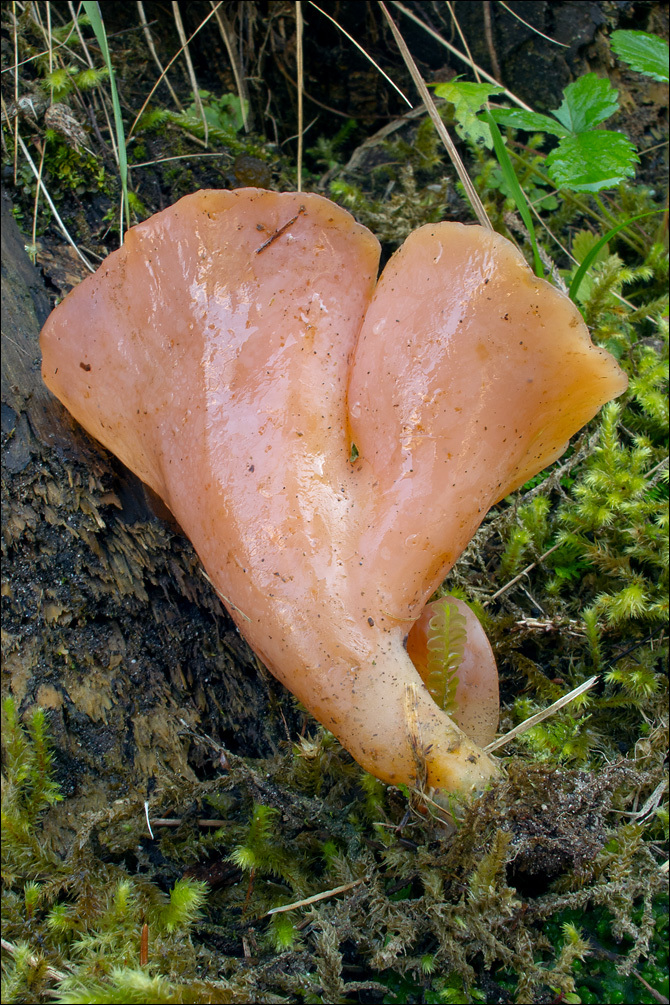
Slo.: uhati drhtave, donk, uhelj - syn.: Guepinia rufa (Jacq.) Beck, Phlogiotis helvelloides (DC.) G.W. Martin, Tremella helvelloides DC., Tremiscus helvelloides (DC.) Donk - Habitat: River bank, wood edge, Picea abies dominant, next to a trail, almost flat terrain, quite-open place, partly sunny, air and ground humid place; calcareous, alluvial, sandy ground; exposed to direct rain, average precipitations ~ 3.000 mm/year, average temperature 7-9 deg C, elevation 565 m (1.850 feet), alpine phytogeographical region. Substratum: soil, possibly buried wood in the last phase of disintegration. Comments: Guepinia helvelloides is not a rare find in Trenta valley. However, this time the find was extremely large, exceeding in size all data in literature I am aware off. Usually the sporocarps are about 5-6 cm tall. Interestingly, also spore width does not fit into expected limits. Spores are significantly larger, so one could suspect a wrong determination of the find. However, to my knowledge, there is nothing similar to this mushroom growing in Slovenia. Growing solitary, two pilei fuzzed at the base; dimensions of the larger 11.5 x 10 cm across and 10.5 cm tall; stipe rudimentary, about 2 cm long and 1.5 cm in diameter, partly hollow; taste mild pleasant, mushroomy; smell indistinctive, on moss(?), SP white, oac909. Spores minutely warty. Dimensions: 9.6 [10.8 ; 11.2] 12.4 x 6.1 [7 ; 7.3] 8.2 microns; Q = 1.3 [1.5 ; 1.6] 1.8; N = 38; C = 95%; Me = 11 x 7.1 microns ; Qe = 1.6. Olympus CH20, NEA 100x/1.25, magnification 1.000 x, oil, fresh material; in water. AmScope MA500 digital camera. Herbarium: Mycotheca and lichen herbarium (LJU-Li) of Slovenian Forestry Institute, Vena pot 2, Ljubljana, Index Herbariorum LJF Ref.: (1) M.Bon, Parey's Buch der Pilze, Kosmos (2005), p 324. (2) R.Phillips, Mushrooms, Macmillan (2006), p 350. (3) R.Lueder, Grundkurs Pilzbestimmung, Quelle & Meyer (2008), p 143. (4) R.M. Daehncke, 1200 Pilze in Farbfotos, AT Verlag (2009), p 1071. (5) A. Poler, Veselo po gobe, Mohorjeva druba Celovec (2002) (in Slovenian), p 324. SP 9-12/4-6.5(6) G.J. Krieglsteiner (Hrsg.), Die Grosspilze Baden-Wrttembergs, Band 1., Ulmer (2000), p 128.
-

Slo.: uhati drhtave, donk, uhelj - syn.: Guepinia rufa (Jacq.) Beck, Phlogiotis helvelloides (DC.) G.W. Martin, Tremella helvelloides DC., Tremiscus helvelloides (DC.) Donk - Habitat: River bank, wood edge, Picea abies dominant, next to a trail, almost flat terrain, quite-open place, partly sunny, air and ground humid place; calcareous, alluvial, sandy ground; exposed to direct rain, average precipitations ~ 3.000 mm/year, average temperature 7-9 deg C, elevation 565 m (1.850 feet), alpine phytogeographical region. Substratum: soil, possibly buried wood in the last phase of disintegration. Comments: Guepinia helvelloides is not a rare find in Trenta valley. However, this time the find was extremely large, exceeding in size all data in literature I am aware off. Usually the sporocarps are about 5-6 cm tall. Interestingly, also spore width does not fit into expected limits. Spores are significantly larger, so one could suspect a wrong determination of the find. However, to my knowledge, there is nothing similar to this mushroom growing in Slovenia. Growing solitary, two pilei fuzzed at the base; dimensions of the larger 11.5 x 10 cm across and 10.5 cm tall; stipe rudimentary, about 2 cm long and 1.5 cm in diameter, partly hollow; taste mild pleasant, mushroomy; smell indistinctive, on moss(?), SP white, oac909. Spores minutely warty. Dimensions: 9.6 [10.8 ; 11.2] 12.4 x 6.1 [7 ; 7.3] 8.2 microns; Q = 1.3 [1.5 ; 1.6] 1.8; N = 38; C = 95%; Me = 11 x 7.1 microns ; Qe = 1.6. Olympus CH20, NEA 100x/1.25, magnification 1.000 x, oil, fresh material; in water. AmScope MA500 digital camera. Herbarium: Mycotheca and lichen herbarium (LJU-Li) of Slovenian Forestry Institute, Vena pot 2, Ljubljana, Index Herbariorum LJF Ref.: (1) M.Bon, Parey's Buch der Pilze, Kosmos (2005), p 324. (2) R.Phillips, Mushrooms, Macmillan (2006), p 350. (3) R.Lueder, Grundkurs Pilzbestimmung, Quelle & Meyer (2008), p 143. (4) R.M. Daehncke, 1200 Pilze in Farbfotos, AT Verlag (2009), p 1071. (5) A. Poler, Veselo po gobe, Mohorjeva druba Celovec (2002) (in Slovenian), p 324. SP 9-12/4-6.5(6) G.J. Krieglsteiner (Hrsg.), Die Grosspilze Baden-Wrttembergs, Band 1., Ulmer (2000), p 128.
-
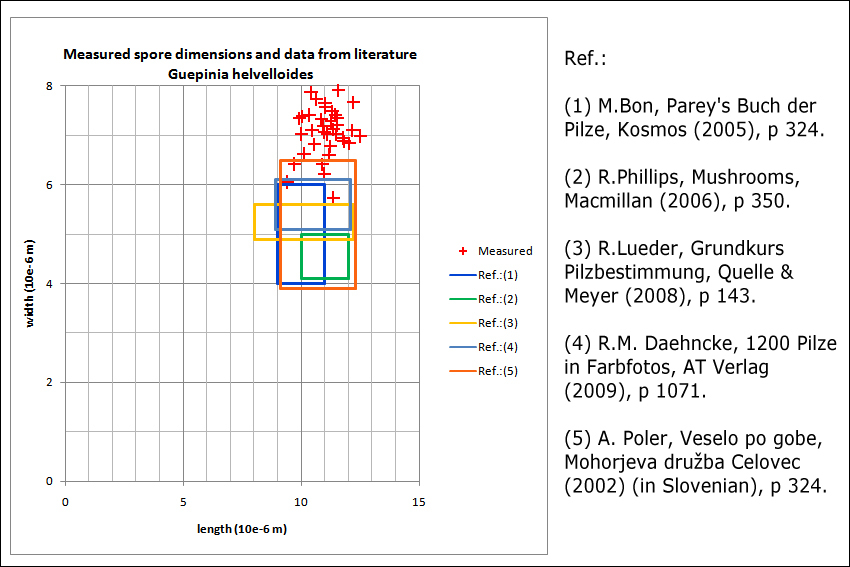
Slo.: uhati drhtave, donk, uhelj - syn.: Guepinia rufa (Jacq.) Beck, Phlogiotis helvelloides (DC.) G.W. Martin, Tremella helvelloides DC., Tremiscus helvelloides (DC.) Donk - Habitat: River bank, wood edge, Picea abies dominant, next to a trail, almost flat terrain, quite-open place, partly sunny, air and ground humid place; calcareous, alluvial, sandy ground; exposed to direct rain, average precipitations ~ 3.000 mm/year, average temperature 7-9 deg C, elevation 565 m (1.850 feet), alpine phytogeographical region. Substratum: soil, possibly buried wood in the last phase of disintegration. Comments: Guepinia helvelloides is not a rare find in Trenta valley. However, this time the find was extremely large, exceeding in size all data in literature I am aware off. Usually the sporocarps are about 5-6 cm tall. Interestingly, also spore width does not fit into expected limits. Spores are significantly larger, so one could suspect a wrong determination of the find. However, to my knowledge, there is nothing similar to this mushroom growing in Slovenia. Growing solitary, two pilei fuzzed at the base; dimensions of the larger 11.5 x 10 cm across and 10.5 cm tall; stipe rudimentary, about 2 cm long and 1.5 cm in diameter, partly hollow; taste mild pleasant, mushroomy; smell indistinctive, on moss(?), SP white, oac909. Spores minutely warty. Dimensions: 9.6 [10.8 ; 11.2] 12.4 x 6.1 [7 ; 7.3] 8.2 microns; Q = 1.3 [1.5 ; 1.6] 1.8; N = 38; C = 95%; Me = 11 x 7.1 microns ; Qe = 1.6. Olympus CH20, NEA 100x/1.25, magnification 1.000 x, oil, fresh material; in water. AmScope MA500 digital camera. Herbarium: Mycotheca and lichen herbarium (LJU-Li) of Slovenian Forestry Institute, Vena pot 2, Ljubljana, Index Herbariorum LJF Ref.: (1) M.Bon, Parey's Buch der Pilze, Kosmos (2005), p 324. (2) R.Phillips, Mushrooms, Macmillan (2006), p 350. (3) R.Lueder, Grundkurs Pilzbestimmung, Quelle & Meyer (2008), p 143. (4) R.M. Daehncke, 1200 Pilze in Farbfotos, AT Verlag (2009), p 1071. (5) A. Poler, Veselo po gobe, Mohorjeva druba Celovec (2002) (in Slovenian), p 324. SP 9-12/4-6.5(6) G.J. Krieglsteiner (Hrsg.), Die Grosspilze Baden-Wrttembergs, Band 1., Ulmer (2000), p 128.
-
2014 California Academy of Sciences
CalPhotos
Guepinia is a genus of fungus in the Auriculariales order. It is a monotypic genus, containing the single species Guepinia helvelloides, commonly known as the apricot jelly. The fungus produces salmon-pink, ear-shaped, gelatinous fruit bodies that grow solitarily or in small tufted groups on soil, usually associated with buried rotting wood. Armstrong Redwoods State Natural Reserve is a state park in California, United States, preserving 805 acres (326 ha) of Coast redwood trees (Sequoia sempervirens). The reserve is located in Sonoma County, just north of Guerneville, California.
-
2014 California Academy of Sciences
CalPhotos
Guepinia is a genus of fungus in the Auriculariales order. It is a monotypic genus, containing the single species Guepinia helvelloides, commonly known as the apricot jelly. The fungus produces salmon-pink, ear-shaped, gelatinous fruit bodies that grow solitarily or in small tufted groups on soil, usually associated with buried rotting wood. Armstrong Redwoods State Natural Reserve is a state park in California, United States, preserving 805 acres (326 ha) of Coast redwood trees (Sequoia sempervirens). The reserve is located in Sonoma County, just north of Guerneville, California.
-
Øster Sundby, Aalborg
-
Øster Sundby, Aalborg
-
Øster Sundby, Aalborg























